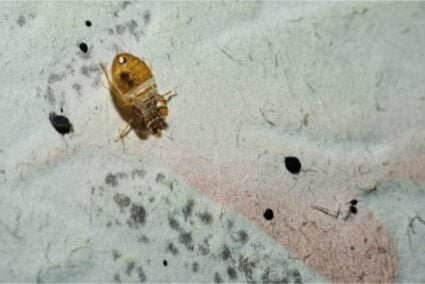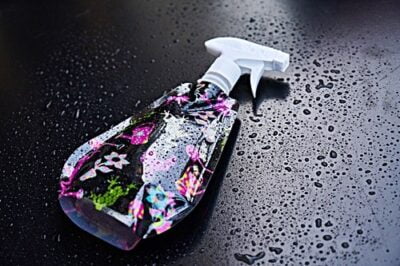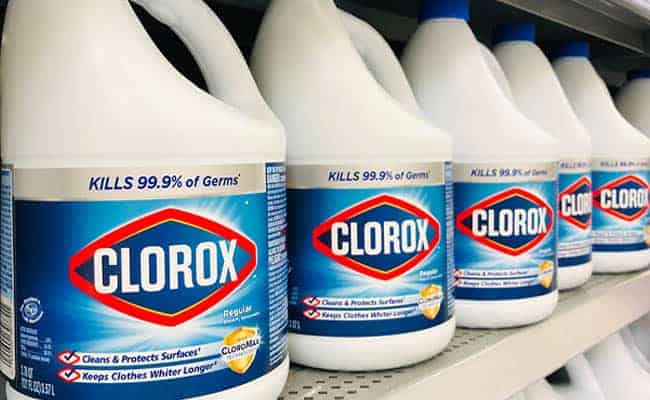If you’ve just recently discovered you have a bed bug infestation, your mind is probably scrambling to come up with an easy solution.
Immediately, you’ll weigh your options and consider some of the most potent chemicals you have on hand. Surely, bleach will kill bed bugs and their eggs.
Bleach (sodium hypochlorite) is often the first product people turn to when they need to sterilize an area. But while it is potent, it isn’t the safest option or the best bug treatment.
Are Bed Bugs Resistant to Bleach?
If you’re trying to get rid of bug beds fast, then grabbing a jug of bleach and launching an attack is probably very tempting. However, using bleach on a mattress is never a good idea. Bleach is potent, and it can lead to respiratory problems if inhaled or severe skin irritation.
Dealing with bed bugs is scary and frustrating, especially if you’ve already tried a variety of natural remedies to get rid of bed bugs permanently, with no luck.
Aside from sprays, many home remedies can be used to tackle the problem. However, hiring a pro will be the fastest and easiest solution.
If you’re not dealing with a significant issue, combating an infestation on your own is possible. Are bed bugs resistant to bleach? No, but they can still be difficult to kill, even with this harsh chemical.
If you’re desperate to get rid of the bed bugs quickly, there are some tricks you can try when using bleach to get rid of bed bugs for good.
Undiluted bleach will kill bed bugs if you pour it directly over them. But if you’ve seen how fast these tiny parasites move, and you’re dealing with hundreds of thousands of them, then dousing all of them may be almost impossible.
Using undiluted bleach to kill bed bugs will work more effectively. If not diluted, the bleach can cause permanent damage to your mattress, clothing, bedding, and other treated surfaces.
How to Treat Bed Bugs with Bleach
Before you launch your attack, make sure you get rid of other objects and any clutter in the surrounding area. This will involve moving most of your things out of your bedroom including throw rugs, pillows, clothing, pictures, etc.
You’ll also want to wash any bedding including your pillows, pillowcases, throws, comforters, and sheets. This applies to sheets you’ve just washed.
Your clothing should be washed in hot water and dried for at least one hour. Heat is deadly for bed bug eggs, nymphs, and even the adults.
After you’ve cleared the room, vacuum it. Once you’ve completed this step, even if the vacuum bag isn’t full, you’ll need to toss it out.
Homemade Bleach Bed Bug Spray
Now, you’re ready for the bleach. Straight bleach works the best, but using straight bleach can cause breathing problems and can seriously damage the surface of your mattress. Instead, you’ll have to dilute the bleach using equal parts of hot water.
Put on a pair of gloves and soak a washcloth in the solution. Wipe down every washable surface in the room. When it’s time for the mattress, place the water and bleach mixture in a spray bottle and spray down the box spring and the mattress. The mattress should not be used for at least two weeks after it has been sprayed.
Getting Rid of Bed Bugs with Bleach
Getting rid of these pesky parasites can be a challenge, especially if you use diluted homemade bed bug bleach spray. But if you tackle the entire room, including all washable surfaces, you’ll have a better chance of getting rid of these guys for good.
We also recommend using the bleach on any other surfaces in the room including the baseboards, floors ( unless you have carpet) headboards, nightstands, and any other place possible.
Once you’ve finished bleaching everything down, you’ll need to steer clear of that particular room for a few days.
An excellent way to boost the effectiveness of bleach treatment is to expose your furniture, especially the mattress and box spring, to bright sunlight.
After leaving the mattress outdoors in the sun for a period of eight to twelve hours, seal the mattress in a plastic cover for six to twelve months.
Doing so ensures the bugs will suffocate and die and you’ll never have to deal with another bed bug infestation.
As you’re avoiding the infested room, make sure to clean it once daily. You can wipe down all of the same surfaces using bleach, but avoid repeat treatment on the mattress and box spring.
When cleaning the room, make sure you vacuum out every nook and cranny, including dresser drawers and the floor of your closet.
What Makes Bleach so Powerful?
Do you want to know will bleach kill bed bugs, but you’re not even sure what’s in bleach? Let’s get a quick rundown of the active ingredients in bleach to find out why this chemical is highly recommended for self-treating pests.
Below, the following ingredients are found in both name brand and off-brand bleach:
- Sodium chloride
- Sodium hypochlorite
- Water
- Sodium chlorate
- Sodium carbonate
- Sodium polyacrylate
- Sodium hydroxide
While it may sound powerful, sodium chloride is just table salt. It’s often used as a stabilizer in a wide range of cleaners and soaps such as laundry detergent, hand soap, and dish soap. Sodium hypochlorite is the main active ingredient, and it works to whiten your clothes and kills germs.
Additionally, sodium chlorite is the natural breakdown of this chemical. Sodium carbonate softens water and can help remove tough stains. Sodium polyacrylate prevents dirt from becoming reabsorbed into materials as they’re being washed.
Now that you know a little more about bleach and what it’s made out of let’s look at how it works to kill bed bugs.
As we’ve already discussed, bed bugs are tough to kill since they’re so small they can hide inside a mattress and any tiny crevice or crack that’s located near their food source. These bugs can also lay eggs that are resistant to many chemicals.
So, how is bleachable to destroy bed bugs and their eggs? The bleach works by oxidizing the shell’s outer layer and by oxidizing the body of the nymph and the adult. This is accomplished thanks to sodium hypochlorite.

Boosting Treatment Effectiveness
If you’ve washed, vacuumed, and bleached your room, if you’re still not confident you’ve killed the bugs and their eggs, heat will be the perfect tool to use that can complement the bleach treatment. Most pros can agree that heat is one of the best methods to use to kill eggs, nymphs, and adults.
Once these bugs are exposed to one hundred and twenty degrees, both the eggs and the bugs themselves will die almost instantly.
Because of this, heat is the best choice concerning treating clothing. You can easily zap these bugs by placing stuffed animals, throw pillows, blankets, and clothing in your dryer for just a few minutes.
Many professional pest control companies have used this concept to create heating equipment that’s powerful enough to generate enough heat to treat an entire home.
But if you can’t afford expensive household treatments, which can easily run one to five hundred dollars, depending on the size of your home and the number of rooms that need treatment, the next best thing is a hairdryer. On average, the hair dryer can reach up to one hundred and thirty degrees.
This will be very time-consuming, but if you and your family can pull together, you can easily tackle this problem. Using a hair dryer to treat carpets, and other affected surfaces should only be done after you’ve used bleach and the bleach has had time to dry. We recommend waiting a minimum of twenty-four hours after bleach treatment.
Combined, both treatments will work to eliminate a manageable infestation with just one treatment. It also minimizes the type of chemicals that are used in the home.
If you’re thinking of heat treating your home using portable heaters, you should understand that the heat needs to be applied evenly, but not constantly.
Using a hair dryer, you’ll use a slow up and down or side to side motion, so the heat will not remain in one spot constantly. The constant application of heat can scorch your carpet or furniture.
Using heat is also a great option if you have surfaces you can’t use bleach on, such as a couch or your carpet.
Are Bed Bugs Attracted to Bleach?
Bed bugs are not attracted to bleach. They will immediately run from it once the bleach makes contact with the mattress or any other surface the bleach is applied to.
One of the tricky things about trying to kill bed bugs using bleach is the fact that you may need to do repeat treatment if you’re dealing with a severe infestation.
As the bugs flee once they detect the bleach, they often burrow into the mattress, where the bleach cannot touch them. Sure, you can pour the bleach directly on to the surface of the mattress, but then the mattress will no longer be safe to use.
Diluted bleach will be the only safe option if you’re using this treatment inside the home.

If the bleach doesn’t work, or you want to use another method to help boost its effectiveness you can also try steaming the mattress and other furniture in the room.
Unfortunately, bed bugs can be tough to kill and can be resistive to many sprays that are specifically designed to kill them. But bed bugs can also be challenging to detect in the first place.
These insects only tend to come out at night, to feed. When not feeding they can be found in areas that are difficult to access, such as tight crevices and cracks.
Is Tackling an Infestation Yourself the Best Option?
If you want to treat bed bugs yourself, it can save you a lot of money, but only if you get on this problem quickly. If you’ve been dealing with bed bugs for several weeks, then this type of infestation can grow to become as costly as hiring the pros.
When it comes to home treating the bed bugs with bleach and heat or hiring professionals it essentially boils down to how much time and energy you’re willing to spend on this problem and what your budget looks like.
Bed Bug Prevention
Once you’re finally rid of the infestation, buy bed bug box spring and mattress covers. Both types of covers will lock in any eggs and bugs that are left in your mattress and can kill them over time.
Of course, some people may feel better getting a new mattress and box spring. If you can’t afford to replace your bed, this option is the next best thing and one that can save you hundreds of dollars.
Another option is installing traps for bed bugs under furniture and your bed posts. These traps will prevent you from being bitten while you sleep and can even help you to determine where these pests are hiding.
While the mattress and box spring covers will prevent bugs in your mattress from attacking during the night, the traps will kill any bugs that are not in your mattress. Other ways you can avoid infestations in the future include the following:
- Keep your clothing in vacuum-sealed bags. Place any clothes you won’t be wearing for the season in vacuum-sealed bags to prevent clothing that’s not used regularly from being infested.
- Learn the early signs of bed bug infestations. Often, the first sign is bug bites. These bites are itchy and usually appear in rows. Knowing what these bites look like can help you to quickly tackle a new infestation problem right away for better results.
- Vacuum regularly. Despite common belief, bed bugs aren’t just found in beds. Bed bugs will hide in carpets and furniture. Because of this, it’s important to regularly vacuum your whole house to ensure all the bugs and eggs are eliminated quickly.
- De-clutter your home. Make sure you avoid clutter in the home. The more clutter you have in each room, the more likely you’ll be to get another bed bug infestation.
- These bugs can enter the home in many ways. Apply or repair silicone caulk to crevices and cracks on the inside and outside of your house. Keep in mind, any opening that’s large enough to fit a credit card is the perfect place for bed bugs to hide. Also, make sure you check windows and screens for holes and tears and replace or repair as needed.
- A bed bug can travel on animals, shoes, or clothing. They can also be picked up at public places such as restaurants, buses, even the movie theater. Tossing your coats, shoes, and clothing in your dryer for a few minutes can be an easy way to keep them pest-free.
Getting rid of bed bugs and preventing another infestation is not easy. Fortunately, products such as bleach are affordable, simple to use, and can work to help you get rid of bed bugs without the use of powerful chemicals throughout your home.
Multiple treatments can often be the best strategy for eliminating mild to moderate infestations. Will bleach kill bed bugs instantly? Yes, but you’ll need to do repeat treatments to get all of the bugs and the eggs.
If you use a multi-pronged home treatment, such as adding steam, vacuuming regularly, and using hair dryers, then you can easily get rid of your pest problem in a couple of days.
If you have a large home and the infestation has spread to multiple rooms, the best, easiest, and fastest way may be to call the pros.
Using two or three methods is an effective way to tackle the problem since another treatment can kill the eggs and bugs the previous treatment did not.
It will all be a matter of how much time and energy you’re willing to put into this project and how much money you can afford to spend treating it yourself.

